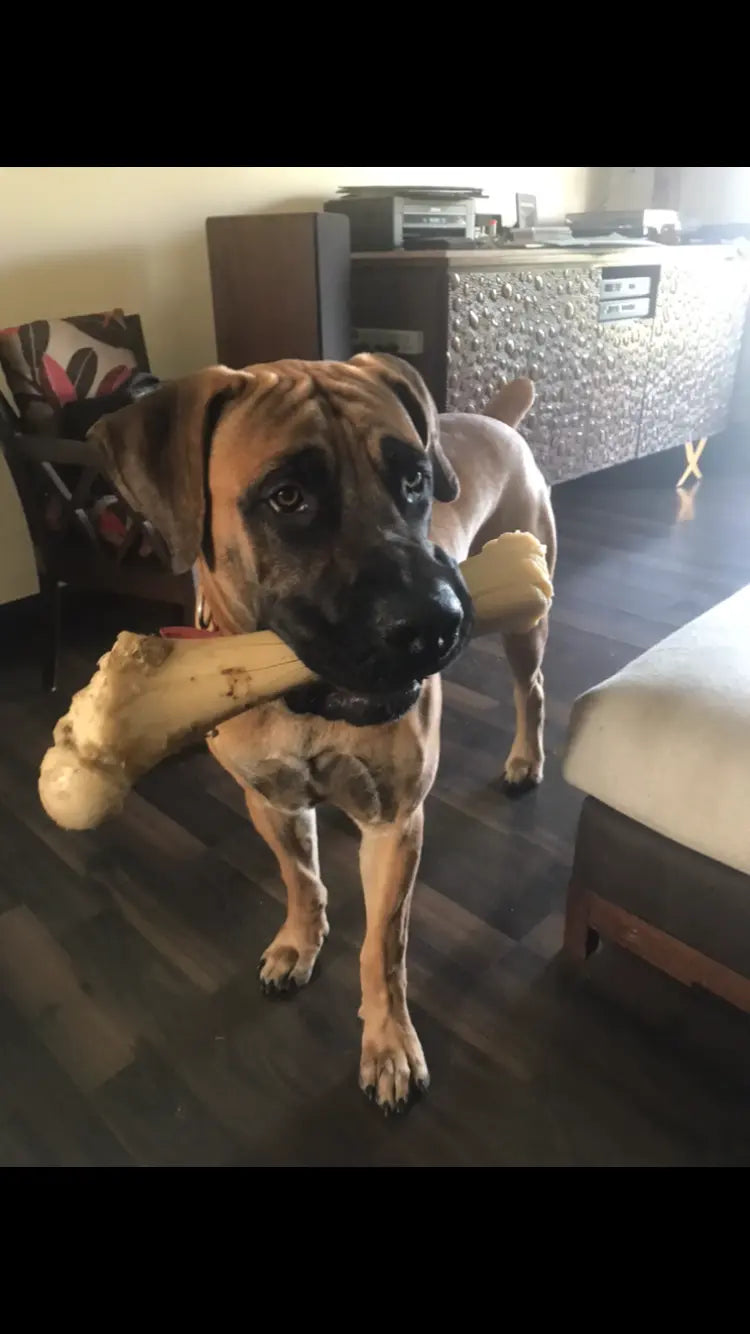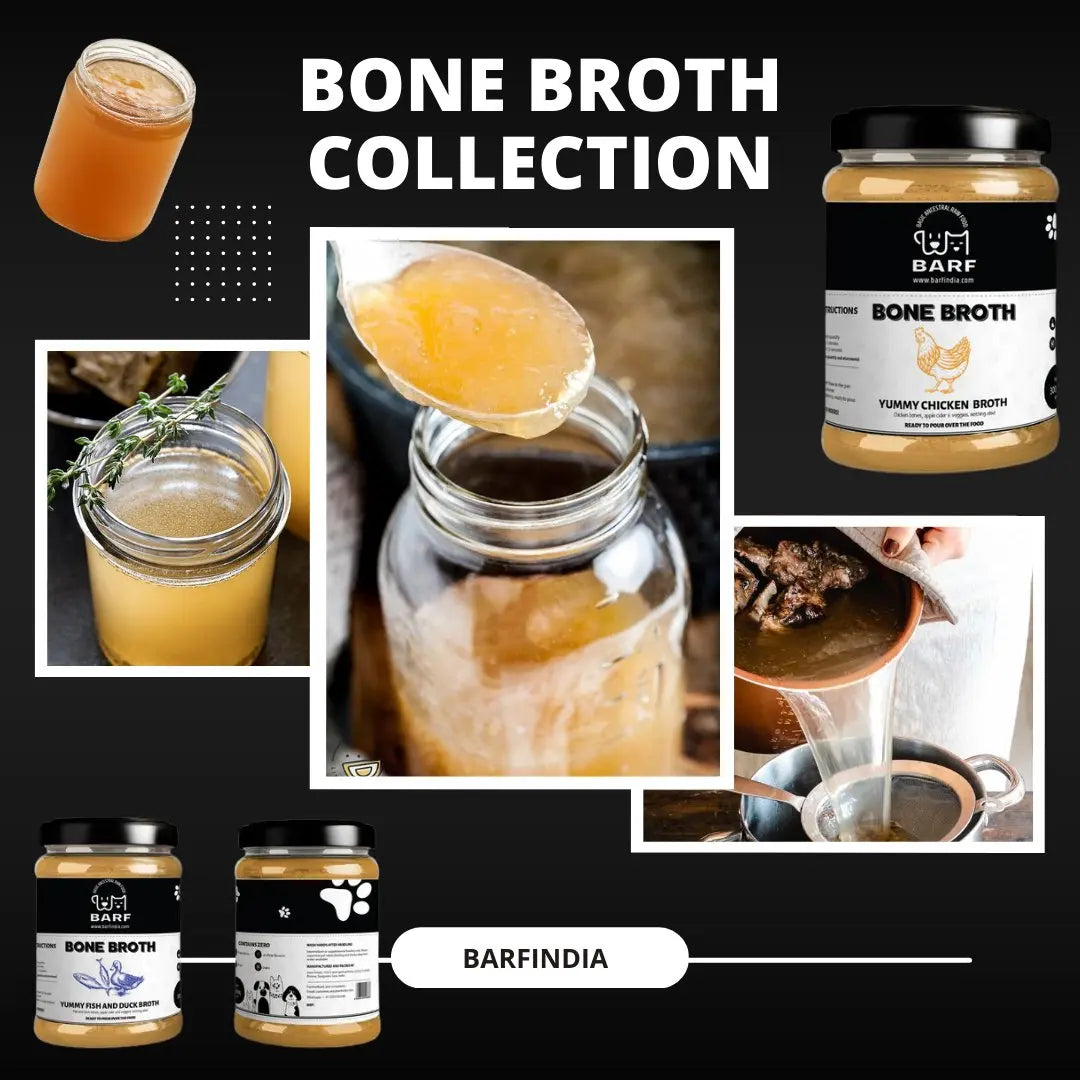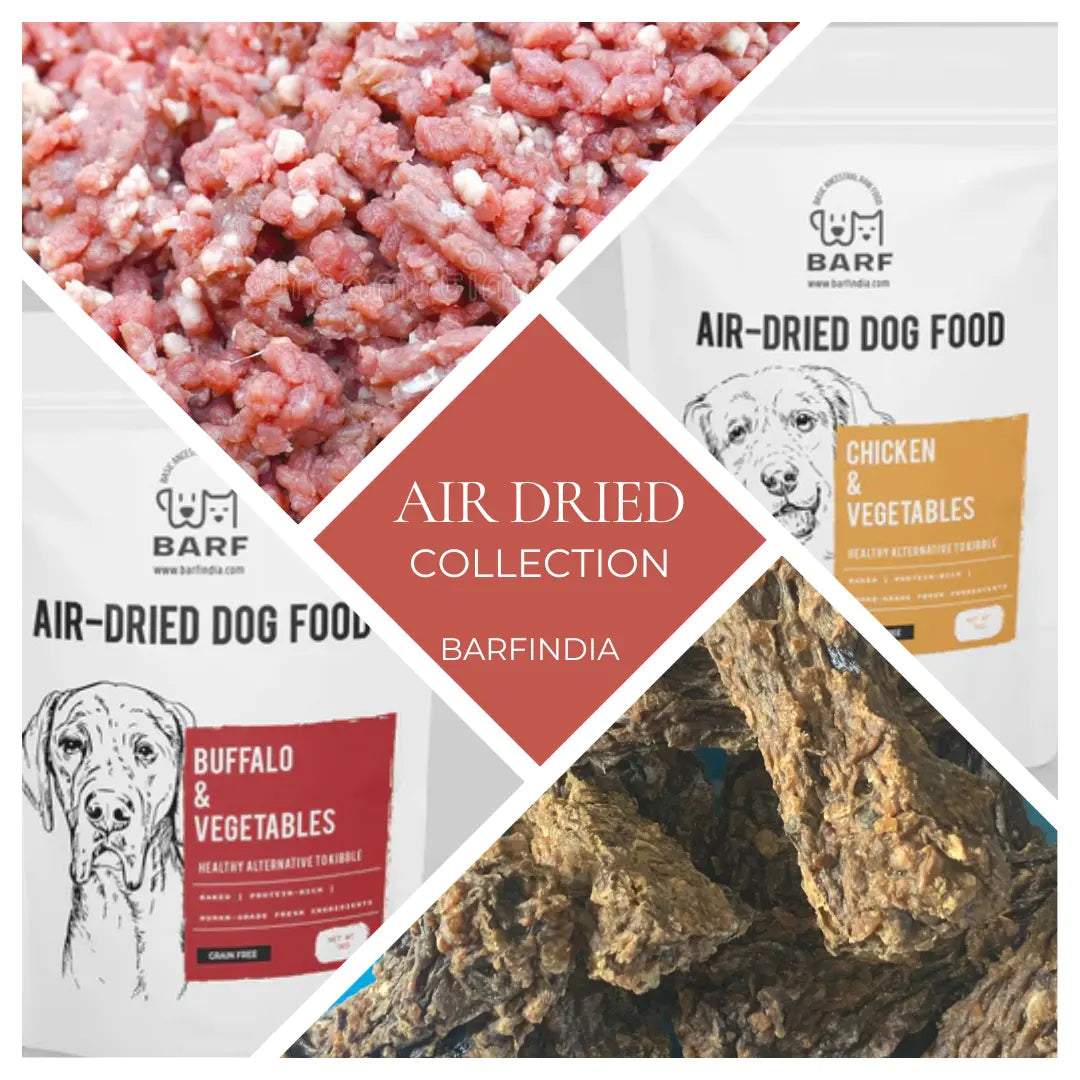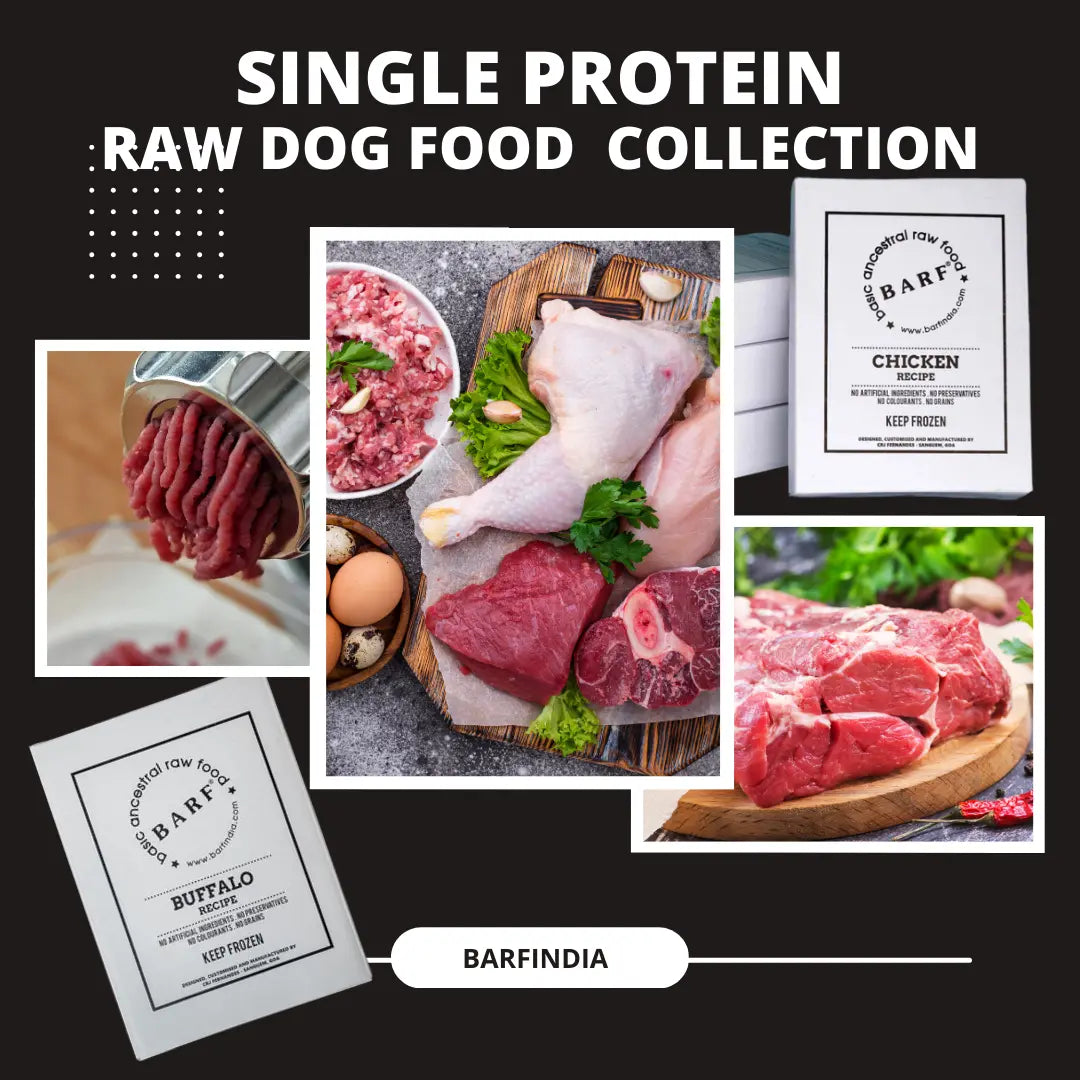
Choosing the Best Natural Chew Bone for your dog
Nivedita FernandesChew Bones for Dogs: The Ultimate Guide to a Natural, Healthy Treat
Picture your dog’s tail wagging furiously as they sink their teeth into a raw knuckle bone—a treat that’s as wholesome as it is fun! Chew bones for dogs are more than just a pastime; they’re a natural way to support your pet’s health, happiness, and instincts. In this comprehensive guide, we’ll explore everything you need to know about chew bones, from their benefits to safety tips, ensuring you can confidently add them to your dog’s routine. Whether you’re a seasoned pet parent or new to natural treats, this 3000-word blog will help you make informed choices about chew bones for dogs.
Introduction: Why Chew Bones Matter
Dogs have been chewing on bones for centuries, a behavior rooted in their wild ancestors who relied on bones for nutrition and entertainment. Today, chew bones for dogs, especially raw knuckle bones, offer a modern take on this ancient practice. These natural chews provide a range of benefits, from cleaner teeth to happier minds, all while being a sustainable alternative to synthetic toys. But with so many options and concerns, how do you choose the right chew bone and use it safely? Let’s dive in.
What Are Chew Bones for Dogs?
Chew bones for dogs are natural chews, typically sourced from beef or bison, that include cartilage, tendons, and marrow. Raw knuckle bones, a popular type, are large, hard bones designed for prolonged chewing rather than complete consumption. Unlike processed treats or plastic toys, these bones tap into your dog’s instinctual need to chew, offering a wholesome, unprocessed option that supports their well-being. The mix of textures—crunchy bone, chewy cartilage, and rich marrow—makes them irresistible to dogs of all sizes.
The Benefits of Chew Bones for Dogs
Chew bones offer a host of benefits that make them a standout choice for pet owners. Here’s a closer look:
Dental Health: Nature’s Toothbrush
One of the most significant advantages of chew bones is their ability to promote dental health. As dogs gnaw, the mechanical action scrapes away plaque and tartar, reducing the risk of gum disease and bad breath. Increased saliva production during chewing also has natural antibacterial properties, helping to keep your dog’s mouth clean. Imagine your dog sporting a brighter smile and fresher breath after regular chew sessions—no more shying away from those puppy kisses! While chew bones aren’t a substitute for veterinary dental care, they can extend the time between cleanings and support overall oral health.
Mental Stimulation: A Happy, Engaged Dog
Dogs are born chewers, and satisfying this instinct is key to their mental well-being. Chew bones provide hours of engagement, helping to alleviate boredom and reduce anxiety. For high-energy dogs or those prone to destructive behaviors, a chew bone can be a lifesaver, redirecting their energy from your furniture to a wholesome treat. The act of chewing releases endorphins, promoting a sense of calm and contentment. Even older dogs benefit, as chewing keeps their minds sharp and active.
Nutritional Value: A Nutrient-Rich Treat
Raw knuckle bones are packed with essential nutrients like calcium and phosphorus, which support strong bones and teeth. The marrow contains healthy fats, while cartilage provides collagen, which may aid joint health. These nutrients are delivered in a natural, bioavailable form, making them easy for your dog to absorb. In the wild, canines rely on bones as part of their diet, and offering your dog a chew bone brings a taste of that natural nutrition into their modern life.
Joint Health: Supporting Mobility
The collagen in cartilage and marrow is believed to support joint health, potentially improving mobility and comfort, especially in dogs with arthritis or joint issues. While more research is needed, many pet owners report positive changes in their dogs’ movement after incorporating chew bones into their routine. It’s a natural way to support your dog’s long-term health.
Digestive Health: Aiding Digestion
Chewing stimulates digestive enzymes, aiding food breakdown. For dogs on raw diets, bones can help firm up stools by binding food particles, promoting better digestive health. However, moderation is key to avoid digestive upset from overconsumption.
Teething Relief for Puppies
Puppies going through teething need to chew to soothe their gums. A chew bone provides a safe, durable option to ease discomfort, saving your shoes and furniture from becoming chew toys. It’s a natural way to support your puppy during this transitional phase.
Types of Chew Bones: Edible vs. Recreational
Not all chew bones are the same, and understanding the difference helps you choose the right one:
|
Type |
Description |
Examples |
Purpose |
|---|---|---|---|
|
Edible Bones (RMBs) |
Smaller, softer bones with meat and cartilage, meant to be consumed entirely. |
Chicken necks, turkey wings, rabbit bones |
Provide nutrition as part of a raw diet. |
|
Recreational Bones |
Larger, harder bones designed for chewing, not eating whole. |
Knuckle bones, femur bones, marrow bones |
Offer dental and mental benefits. |
Raw knuckle bones fall into the recreational category, ideal for prolonged chewing sessions, especially for larger dogs or aggressive chewers.
Safety Considerations: Keeping Your Dog Safe
While chew bones offer significant benefits, safety is paramount. Here are the key considerations:
Choosing the Right Size
The bone must be larger than your dog’s mouth to prevent choking or swallowing whole. For example, a small dog might need a smaller recreational bone, while a large breed requires a substantial knuckle bone. Always choose a bone that’s too big to be swallowed.
Raw vs. Cooked
Only raw bones should be given, as cooked bones can splinter, causing internal injuries or choking. Raw bones are flexible and less likely to break into sharp pieces, making them safer.
Supervision
Always supervise your dog during chewing sessions, especially if they’re new to bones or aggressive chewers. This allows you to intervene if they break off large pieces or show signs of distress. Remove the bone after 10-15 minutes to prevent overconsumption.
Health Considerations
Not all dogs are suitable for chew bones. Puppies with developing teeth, seniors with dental issues, or dogs prone to pancreatitis may be at risk. Dogs with sensitive stomachs or certain health conditions should avoid bones. Consult your veterinarian before introducing chew bones.
Sourcing and Handling
Source bones from reputable suppliers to ensure they’re free from harmful bacteria like Salmonella or E. coli. Proper handling is crucial—keep bones frozen, thaw in the refrigerator, and discard uneaten portions after three to four days to prevent bacterial growth.
Specific Risks
-
Bacterial Contamination: Raw bones can carry pathogens, posing risks to dogs and humans. Hygienic handling and quality sourcing mitigate this.
-
Choking and Blockages: Large bone pieces can cause choking or intestinal blockages. Supervision and size-appropriate bones reduce this risk.
-
Tooth Damage: Hard bones can crack teeth, especially in aggressive chewers. Choose bones that match your dog’s chewing style.
-
Pancreatitis: The fat in marrow can trigger pancreatitis in susceptible dogs. Opt for low-marrow bones if needed.
How to Use Chew Bones Safely
To ensure a positive experience, follow these guidelines:
Introduction to Bones
Start with short chewing sessions (10-15 minutes) to gauge your dog’s reaction. Monitor for digestive upset or discomfort. Gradually increase duration if all goes well.
Frequency
Offer recreational bones 1-2 times per week as a treat, not a meal replacement. This frequency provides benefits without risking overconsumption.
Storage and Preparation
Store bones in the freezer to maintain freshness. Thaw in the refrigerator for 24 hours before serving, and use within 24 hours of thawing. Serve on a non-slip surface to prevent frustration or injury.
Monitoring Health
Observe your dog’s stool consistency after introducing bones. Hard, chalky stools may indicate too much bone, while loose stools could suggest an imbalance. Adjust frequency or size as needed. Regular vet check-ups ensure bones are benefiting your dog without issues.
Training for Appropriate Chewing
Teach your dog to chew appropriately to protect your belongings:
-
Introduce Early: Start with puppies to establish good habits.
-
Redirect: If they chew on furniture, calmly redirect to their bone.
-
Praise: Reward them for choosing their bone.
-
Consistency: Set clear boundaries about what’s okay to chew.
Common Myths and Misconceptions
Let’s debunk some myths about chew bones:
-
Myth 1: Raw Bones Cause Bacterial Infections
Dogs’ strong stomach acids typically neutralize pathogens like Salmonella. Quality sourcing and proper handling further reduce risks. -
Myth 2: Bones Always Splinter
This applies to cooked bones, which are brittle. Raw bones are flexible and less likely to splinter when sized correctly. -
Myth 3: Chew Bones Are Only for Large Dogs
Small dogs can benefit from appropriately sized bones, ensuring they enjoy the same dental and mental advantages.
Environmental and Ethical Impact
Chew bones are an eco-friendly alternative to plastic chew toys, reducing landfill waste. Sourcing from ethically raised animals supports sustainable farming, aligning with the values of environmentally conscious pet owners. By choosing natural bones, you’re making a small but meaningful contribution to a greener planet.
Choosing the Best Chew Bone for Your Dog
Consider these factors when selecting a chew bone:
-
Size and Breed: Larger dogs need denser bones like beef knuckle bones, while smaller dogs may do better with smaller recreational bones.
-
Chewing Style: Aggressive chewers require durable bones, while moderate chewers can handle softer options.
-
Health Needs: For dogs prone to pancreatitis, choose low-marrow bones. Consult your vet for specific needs.
-
Source: Opt for bones from trusted pet suppliers, not kitchen scraps, to ensure safety.
Alternatives to Chew Bones
While chew bones are unique, alternatives include:
-
Dental Chews: Designed for oral health but may lack nutritional benefits.
-
Rubber Toys: Durable but not edible, missing the natural appeal of bones.
-
Antlers: Long-lasting but harder, posing a higher risk of tooth damage.
-
Rawhides: Often processed with chemicals, making them less natural than bones.
Chew bones stand out for their combination of dental, mental, and nutritional benefits, making them a top choice for many dogs.
A Day in the Life: How Chew Bones Transform Your Dog’s Routine
Imagine a typical day with your dog, Max, a lively Labrador. In the morning, Max is full of energy, chasing his tail and eyeing your couch. You offer him a raw knuckle bone, and his focus shifts. For the next 15 minutes, he’s engrossed, gnawing happily, his tail wagging. By lunchtime, you notice his breath is fresher, and his teeth look cleaner. Over the weeks, Max seems calmer, less prone to chewing your shoes, and his vet remarks on his improved dental health. The bone, stored in the freezer and thawed as needed, becomes a weekly treat that keeps Max healthy and happy. This simple addition transforms his routine, and yours, for the better.
FAQs About Chew Bones for Dogs
-
Can all dogs have chew bones? Not all dogs are suitable. Puppies, seniors, or dogs with health issues should be evaluated by a vet first.
-
How do I know if the bone is too small? If your dog can fit the entire bone in their mouth, it’s too small. Choose a larger bone.
-
Are raw bones safe from bacteria? With proper sourcing and handling, the risk is minimal, as dogs’ stomachs can handle many pathogens.
-
How often should I give my dog a chew bone? 1-2 times per week is ideal for recreational bones.
Conclusion: A Natural Choice for Your Dog
Chew bones for dogs, particularly raw knuckle bones, offer a natural, engaging, and nutritious way to enhance your pet’s life. From cleaner teeth to happier minds, these bones tap into your dog’s instincts while providing health benefits that synthetic chews can’t match. By choosing the right bone, supervising chewing sessions, and sourcing from trusted suppliers, you can ensure a safe and rewarding experience. Whether your dog is a playful puppy or a seasoned chewer, a chew bone can be a game-changer. So, why not add one to your cart today and watch your furry friend thrive?



